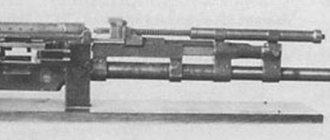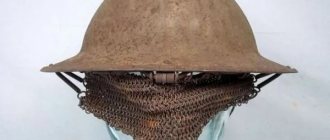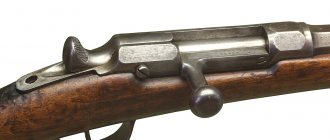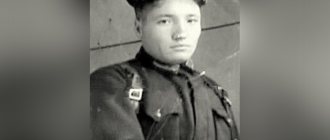Throughout its existence, the Russian helmet has been the pride of Rus' and the Russian state. His chronicle begins from the 9th century - the beginning of the reign of the Rurikovichs. But the helmet was also previously on the territory of the future Kyiv and Novgorod principalities. The only point is that the history of Rus' is inextricably linked with this armor. It developed along with the formation of the state, defended its borders and foundations, protecting Russian soldiers. Being an element of protective equipment, the helmet covered the most vulnerable part of the body - the head. It was she who was most protected among all peoples, in any era. At the same time, the helmet was not just protection, but also a sign of difference between rich warriors and ordinary ones.
If you love intellectual relaxation, then you probably do crossword puzzles or scanword puzzles in your spare time. Of course, this is a very exciting activity that allows you to expand your horizons and demonstrate your erudition.
Just how often have you encountered a situation where you need to guess, for example, a 6-letter word that you have no idea about? Most likely, you will remember more than one such case when, due to such an unfortunate misunderstanding, another scanword puzzle remained incompletely solved. But now you have a unique assistant - the Crossopen.ru !
Answers to scanwords on VKontakte, Odnoklassniki and many others
What is our service?
It will replace you with many dictionaries, encyclopedias and well-read relatives with whom you previously consulted if you were unable to find the right word on your own. With Crossopen.ru you can easily solve a crossword puzzle of any difficulty level using an intuitive search form.
The main advantage of our service is a huge database of words and questions for which you can find the appropriate answer. A user-friendly interface will provide you with a quick search for words of 3, 4, 5 or more letters . It is important to note that at the same time you can clarify your request by indicating the subject, as well as the letters you already know - the so-called word search by mask .
Let's look at the interface using a clear example: you need to find out the poet's last name, which has 6 letters, and the third is “sh”. You set up a search for 6-letter words, click on the corresponding empty cell and insert the letter you know, after which you specify the keyword - “poet”. As a result, you get various options, one of which is sure to be correct. This way you can find any answers to crossword puzzles , because it’s very simple!
You can solve any crossword puzzle!
Our service is absolutely free, and you can freely use it to search for answers to any crossword or scanword puzzle, both from the newspaper and on the Internet. For example, our database contains almost all the answers to Odnoklassniki and VKontakte crossword puzzles, which will allow you to solve them quickly and with pleasure.
Plus, you can create these kinds of brain teasers yourself! To do this, just list the words in alphabetical order and choose the options that suit you with descriptions so that the resulting crossword puzzle is interesting and educational.
So if you like to solve crosswords, the Crossopen.ru will become a convenient and reliable assistant for you. Spend your free time doing your favorite activity with pleasure!
Evolution of the helmet
Helmets originated at the dawn of civilization and were improved over thousands of years. Thus, during the primitive communal period, all kinds of available materials were used to protect the head during battle. Birch bark, wood, intertwined rods or leather were used.
Over time, metal processing methods have improved. Blacksmiths began to forge helmets from gold, copper, and bronze. Back then, only very noble people could afford such a thing. These products were a sign of distinction; they were placed in the tomb along with the deceased during burial.
Ancient world
The oldest helmets, made of copper and gold, were discovered in the Sumerian royal tombs of the state of Urartu . They date back to the 3rd millennium BC. These products are made in the form of a helmet, many of them are equipped with ears or combs.
In Mesopotamia of the same period, models of spheroconic or egg-shaped shapes were also found. They were equipped with strips to protect the nose, cheeks and neck. The variety of models suggests that helmets appeared much earlier, having gone through an evolutionary path. From these countries they spread throughout the continent, ending up in Transcaucasia, China, and so on. Each nation made a type of product in accordance with the characteristics of the weapons of its army and the climate of its place of residence.
Only royalty could afford metal armor, and ordinary warriors on the battlefield protected their heads with helmets made from available materials. Thus, the equipment of Egyptian warriors consisted of hats made of leather or linen, which were reinforced with metal plates. Even by the Middle Ages, not all armies wore iron helmets.
The first helmets made of iron appeared in Assyria and Urartu by the 8th–7th centuries BC. e. But they were able to displace simpler and cheaper models made of bronze almost a thousand years later. But helmets with crests or feathers came from the Mycenaean civilization from the Carians. They were used in different variations.
The helmet of an ancient Greek hoplite, coupled with a quadriga of horses harnessed to a chariot, became a symbol of the Hellenic era. At that time, weapons were made of iron, which has survived to this day in very poor condition. But the bronze helmets were well preserved.
In ancient times there was no generally accepted classification of helmets or a single model.
There are several types of helmets that differ in design and production technology. The divisions into models accepted in our time did not exist then, or written sources about them did not survive. In ancient times, helmet names such as Corinthian, Boeotian, and pilos were used. The history of the ancient world is full of legendary conquests. Naturally, the design of helmets and armor changed, as warriors adopted the best from other armies, applying the protection to themselves.
Ancient Sumerian helmet
Helmets of Assyria 8-7 centuries BC
Corinthian helmet - a symbol of Ancient Greece
Pylos
Boeotian helmet, 4th century BC
Middle Ages
In the early centuries of the Middle Ages, the formation of the helmets of European warriors was influenced by eastern cultures. The Sarmatians, Eurasian nomads, fought in this uniform. Initially, frame helmets were common, which were riveted from several segments. This was Spangenhelm. It consisted of strips of metal that made up the frame and riveted bronze or steel plates. The helmet had a conical shape. Often such headdresses were complemented by nose protection or a half-face mask; they were very popular because they were reliable and relatively simple to make. They also had a drawback - the segments could split upon impact.
In the 10th century, Norman helmets were common, without a frame, assembled from segments. They were equipped with nosepieces to protect the face and were shaped like a dome with a pointed, raised center. Such equipment lasted until the 12th century and was replaced by models that provided better protection. But this particular type was worn by archers for a long time, because such a helmet provided better visibility while shooting.
Spangenhelm
Norman type helmet
New models of the 12th-16th centuries
During the Crusades of the 12th century, a large helmet, or tophelm, became part of the equipment. It remained relevant for almost three centuries, undergoing minor changes. This type of equipment was worn by knights and heavy infantry in the Middle Ages.
Topfhelm can be seen in films about Alexander Nevsky.
The shape of the tophelm was a cylinder with a flat top that completely covered the head. There were only small slits for the eyes in the middle part and breathing holes. Later, the tops began to be made more curved or rounded, so that during a direct blow the weapon would slide off. This is how the “sugar loaf” and “toad head” models appeared.
Cerveliers in the European army
Topfhelm had significant disadvantages - a limited field of view and poor ventilation. Under this option, a felt balaclava and a cervelier, which was a helmet, were worn. It was used in the XII-XIV centuries. It was the Cervelier that became the prototype of modern army helmets.
Gradually the cervelier developed. During the main battle, the knight fought in full ammunition. When the fight turned into a chase or hand-to-hand combat, he took off his heavy helmet and remained in the cervelier, which provided better visibility. One of the varieties of this model was the bascinet. By the 15th century, the great helmet had practically fallen out of use and was preserved only in tournaments.
Combat and tournament items
Tournaments appeared by the 11th century, and they were held so that men could show their prowess. For the first three hundred years, warriors performed in knightly combat armor, but over time they began to fight in ammunition that had a more elegant appearance, decorated with heraldic symbols. With the advent of topfhelms, patterns also began to be applied to helmets, and they were also supplemented with horns, crowns, wings, feathers and other attributes.
Helmets for tournaments also changed. The right side of the products was sealed with a felt lining, because it was there that the main blow fell. Helmets began to be made of thicker steel to preserve the health of the knight.
A tournament helmet could weigh up to 10 kg, while a combat helmet could weigh no more than 4 kg.
Also, to absorb energy and shift the direction of impact, helmets began to be made in a round shape. This is how the “toad head” appeared. A closed armet or reinforced salad with a viewing slit was also used.
Performances at tournaments became commonplace at that time. The equipment for them also remained traditional for the medieval period. Thus, the bascinet, which fell out of use on the battlefield by the end of the 14th century, remained a tournament helmet for a long time, as it was very reliable.
With the advent of firearms, armor fell out of use. This was not due to their ineffectiveness, but to their high cost. It was much cheaper to arm an army with firearms than to teach martial arts and acquire knightly armor.
conclusions
The Fakel design bureau began creating a new air defense system of the 9M96 type back in the 80s of the 19th century. The rocket's flight duration was expected to be at least 50 kg. The anti-aircraft missile system is capable of easily maneuvering in the presence of serious overloads and launching charges with a lateral displacement design, which ensured high accuracy in destroying targets. An additional effect was provided by automatically guided warheads. At the same time, it was planned to operate these complexes in the air-to-air format. The Vityaz air defense systems were not so large in size, but at the same time they were in no way inferior in efficiency. They used 9M100 missiles. The main task set before the NATO designer at the time was the development of standardized charges that would strengthen not only internal defense, but would also be excellent for export to other countries of the world.
Modern models of Russian military helmets
Since there are currently much more SSh-68 helmets than is required by the Russian army, their production has been discontinued. Now the Russian military industry is mastering the production of new models of helmets, which are made of new and modern materials on a fabric-polymer basis. New models of helmets are much lighter and more comfortable than their steel counterparts, and most importantly, their protective properties are superior to those of steel helmets.
The first helmet that was produced in Russia using modern materials is called 6B7. It entered service with the Russian army back in 2000. Russian special forces, airborne troops, marines and other similar units received similar protection.
Military helmets, which had been undeservedly forgotten, returned to the world military scene again after the outbreak of the First World War. Currently, the latest military helmets are not just protection for a soldier’s head - they are a real computer, equipped with modern electronics.
Vityaz air defense system: photos, characteristics, video
"Vityaz" is a medium-range anti-aircraft missile system, which is in service with the air defense. Weapons of the S-350 50 R6A series were created by designers of the famous Almaz-Antey corporation. The development of military equipment began in 2007, and this process was led by Ilya Isakov, who holds the position of chief engineer. The planned adoption of the anti-aircraft missile system into service is 2012. Until 2020, the Russian Ministry of Defense planned to buy at least 38 sets. For this purpose, factories for the construction of machines are being built (in Nizhny Novgorod and Kirov). The factories are focused on the production of radar devices and missile systems of the new generation. Next we will look at the indicators and features of this strategic object, which has already been exported.
The Vityaz air defense system began to be developed as a prototype in the early 90s of the 19th century. It was first mentioned as one of the exhibits at the Max 2001 air show. The KamAZ chassis was used as the basis. Modern weapons should become a replacement for the outdated analogue of the S-300 series. And the designers effectively coped with the task.
The improved domestic air defense system is aimed at developing multi-level protection that could protect the outer space and airspace of the state. It prevents strikes from manned aircraft, drones, ballistic missiles and cruise missiles. In addition, it is capable of destroying low-flying objects.
The Vityaz S 350-2017 anti-aircraft missile system will be part of the defense aerospace sector with some limitation of tactical capabilities against missiles. This equipment is slightly smaller than its S-400 counterpart, but belongs to highly mobile military equipment and uses exactly the same charges as those of the 9M96E2 brand. The effectiveness of such weapons was tested in multi-stage tests not only in Russia, but also abroad.
Appointment and presentation
The first prototype of the Vityaz C350E air defense system was publicly demonstrated in St. Petersburg at the Obukhov plant in 2013. Since that time, weapons have been freed from the veil of secrecy. Serial production of air defense systems is carried out at the Almaz-Antey concern. The main producers are the radio equipment plant and the state plant in Obukhov.
The new installation can operate in self-propelled mode together with a fixed multifunctional radar. In addition, there is a command post based on the main chassis and electronic scanning space. The Vityaz S 350 complex was used to protect industrial, social, military and administrative territories from massive attacks carried out by various types of air attacks. The system could be able to repel an attack in a circular sector from a variety of attacks, including extended and short range missiles. The autonomous operation of the anti-aircraft missile system allows it to be part of air defense groups, controlled from command posts. At the same time, the combat configuration of the equipment is carried out completely automatically, while the regular crew monitors only the control and operation of the weapon during combat operations.
Tactical and technical characteristics of the Vityaz air defense system
Modern models of the Vityaz air defense system are located on the BAZ-69092-012 chassis. Below we have given the performance characteristics of this military equipment:
- The curb weight is 15.8 tons.
- Power plant – diesel engine (470 hp).
- The total weight after installation is up to 30 tons.
- Payload – 14.2 tons.
- The depth of the ford is 1700 mm.
- The maximum lifting angle is 30°.
- Hitting ballistic/aerodynamic targets simultaneously – 12/16.
- Parameters of the affected area in terms of maximum height and range (aerodynamic targets) - 30/60 km km.
- Similar characteristics for ballistic type targets - 30/25 km
- The indicator for the synchronous number of induced anti-aircraft controlled charges is 32.
- The period of bringing equipment into combat condition on the march is no more than five minutes.
- The combat crew consists of three people.











